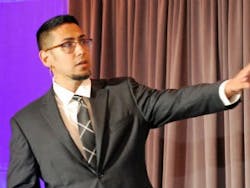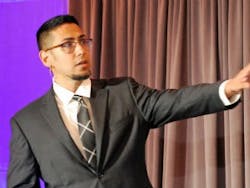“Two years ago, I maybe wasn’t great friends with our IT department, and now people think I work in the IT department.” Greg Aguilar of Celanese spoke of how the company has successfully unlocked siloed data at the 2019 Emerson Global Users Exchange in Nashville, Tennessee.
Some things are just meant to be. When chemicals-maker Celanese began its digital-transformation journey, it wanted to find a way to liberate isolated data and make better business decisions.
Over the course of 100 years, Celanese has evolved from a backyard experiment in Switzerland into a global specialty-materials giant, making intermediate chemistry products, cellulose derivatives, emulsion polymers, food ingredients and engineered materials.
“The problem is having siloed information,” said Greg Aguilar, senior principal instrument engineer at Celanese. He spoke at the 2019 Emerson Global User Exchange in Nashville, Tennessee. “We need to unlock that data and couple it with the business cases for predictive maintenance (PdM), process optimization and energy management.”
Celanese identified more than 50 potential use cases and prioritized them based on feasibility before narrowing it down to two for pilot projects. The use cases were developed with input from people in the units to identify pain points on a day-to-day basis, so they had buy-in. “We included them in every step, from brainstorming to identifying who the solution provider would be. Culture changes are difficult. The successes we’ve seen helped a lot, but it’s still an ongoing battle because people find change to be difficult,” said Aguilar.
“We needed to identify a partner,” he explained. The vendor landscape was vast. “We did a deep dive of 43 vendors in the Industrial IoT (IIoT) space,” he said. “We wanted an analytics platform that could be deployed on premises. We narrowed it down to 12.” Further honing brought the candidates down to six and then two. Finally, Celanese chose KnowledgeNet (KNet) software, but, when Aguilar notified the company, he was surprised to receive a reply from Emerson, which had acquired the software provider. The change was fortuitous for Celanese, however, as the company was already operating numerous Emerson systems, including the DeltaV distributed control system (DCS).
Data analytics spotlights process problem
Using its PdM use case as an example, Celanese set out to test the system with a pilot project analyzing the lube-oil temperature on a rotating piece of equipment. “It looked relatively flat, but the system identified this equipment as an issue,” explained Aguilar. “Looking at the two-month trend, we were still below alarm levels. But, zooming out over the course of two years, the system identified a change in the temperature level. Because the temperature rise occurred over a period of time, no one noticed it on a day-to-day basis. It had gone unnoticed for months before the system picked it up.”
The facility had installed a vacuum dehydrator to remove moisture. “The particular failure we identified had been in place for nine months,” said Aguilar. “It wasn’t seen as a degraded system at the time.”
If the temperature had continued to rise unnoticed, it could have shut down the unit. “We were able to make a decision to add it to our upcoming turnaround scope,” explained Aguilar. “About a month ago, the valve became unstuck, and the temperature dropped 20 degrees. The technology proved it could identify hidden failures.”
The success of the pilot project instilled the type of confidence that the new technology needed. “We’re no longer pushing the technology from corporate down to the sites,” said Aguilar. “Now, they’re asking for it. We’re building institutional knowledge. It gives us a launching point. The technological value accelerates. We are creating a data-driven culture for making decisions.”
The principle-driven failure mode and effects analysis (FMEA) and the system’s linear regression identified the potential damage to bearings. “That particular valve was not considered an issue until the system identified it,” explained Aguilar. “We operate at 100% uptime. We don’t want to take outage time unless necessary. Because we understood the health of the asset, we put a mitigation in place and removed it at the next turnaround in six months. It affected the compressor a bit, but we had the information available to make those data decisions.”
The KNet tool is intended to augment the ability of Celanese technicians and operators. “It’s about freeing up their time to do more value-added tasks,” explained Aguilar. “For instance, in the use case scenario we were considering 80 different variables. One engineer isn’t able to do that. We try to focus on equipment that has repeat failure issues. With the power of the KNet system and the FMEA approach, you can get a lot of value out of it.”
Collaboration with IT has been very important in the system implementation, as well. “IT-OT convergence is happening,” said Aguilar. “Two years ago, I maybe wasn’t great friends with our IT department, and now people think I work in the IT department. The initial journey has been about a year and a half. Over a five-year period, we hope to have a scalable solution.”
About the Author
Mike Bacidore
Mike Bacidore

Leaders relevant to this article:



